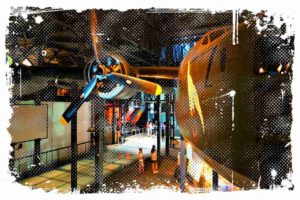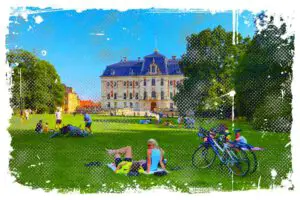These unique churches in Lower Silesia were included in the UNESCO list in 2001, as they are the largest half-timbered religious buildings in the whole of Europe. Churches were built in the mid-17th century as a result of the agreements made after the Thirty Years’ War ended with the Peace of Westphalia. At that time, the Catholic Emperor Ferdinand III of Habsburg was under pressure from Sweden. He agreed to allow three Protestant churches to be built in Lower Silesia. However, he imposed certain regulations. I’m going to explain them in more detail below.

Please, also, read my other article about the most beautiful places in Poland: Exploring Poland’s Cultural Riches: A Guide to UNESCO Cities
How Come Churches of Peace Were Built?
Let’s say we live in Bohemia in 1609. King Rudolf II Habsburg of Bohemia gave religious freedom to all and abolished discrimination between Catholics and Protestants. However, Matthias Habsburg, who came to power two years later, was not so tolerant and began to mistreat the Protestants.
As a result, a remarkable event took place in Hradczany Castle on May 23, 1618. Two imperial governors and a secretary were thrown out of the dining room window by Czech Protestant lawmakers who were enraged by Matthias’s policies.
Interesting fact:
The imperial officials were thrown from a significant height (the castle tower) and yet, amazingly, they remained uninjured! In a surprising turn of events, they were thrown out of the window of the banquet hall. They fell onto a pile of compost – created from the remains of meals thrown out of the same window.
↳ PRO TIP: Do you like traveling? Then before you buy any ticket or book an attraction, check if it's available in this worldwide Viator Database. You may save a lot of money and time. No need to thank me :)
The immediate result of all those above-mentioned events was the beginning of the Thirty Year’s War that involved all the major states of Europe. On one side stood the Catholic Habsburgs, and on the other the Protestant countries of the Holy Roman Empire, supported by several other nations (including Sweden, Denmark, the Republic of the United Provinces, and France).
The Thirty Years’ War, which began as a religious dispute, quickly evolved into a political conflict against the powerful Habsburg dynasty. Other nations saw their vast power as a threat and seized the opportunity to reduce it through war.
The war had a devastating effect on Europe, with the death of over 8 million people, mostly civilians. In some parts of Germany, the death rate was so high that the population was cut in half.
The conflict finally ended in 1648 with the signing of the Treaty of Westphalia. So what role did churches play in all of this?
There Would Be No Churches of Peace if There Were No War
Although the war had ended, communities of different religious beliefs continued to coexist and live in close proximity. After the peace treaty was signed, the Catholic Emperor Ferdinand III Habsburg was pressured by Protestant Sweden to recognize the rights they had been deprived of during the conflict. Although he agreed, it was with great reluctance.
Eventually, he allowed to build three Protestant churches under his jurisdiction, located in Jawor, Glogow, and Swidnica. However, he imposed several strict conditions, which he believed would ensure that the buildings would soon become ruined with the first sign of disturbances.
The Conditions Set by Ferdinand III Habsburg?
Ferdinand III Habsburg imposed several conditions on the construction of these churches:
- Only temporary materials such as straw, clay, sand, and wood could be used in the construction.
- The churches had to be built outside the city limits, but within a cannon shot’s range from the city walls.
- They were not allowed to have the traditional temple shape and couldn’t have towers or bells.
- The construction had to be completed within a year.
- No parochial schools were permitted to operate at the churches.
- The Protestants were required to fully finance the construction on their own.
The emperor probably never expected that the three churches would be completed in less than a year. If he were to see today that two of these churches, in Widnica and Jawor, have withstood the test of time for over 360 years and are still standing strong, he would surely be amazed. Unfortunately, the third church in Glogow had a hard time. It was destroyed by a hurricane in 1654. After it was rebuilt in 1758, it burned down in a big fire in the town.
Churches of Peace
The Peace Churches are substantial structures. They are designed to accommodate large numbers of worshippers. Churches in Jawor and Swidnica have a capacity of 6,000 and 3,000 people respectively. The first of these churches is famous for its annual Peace Concerts, featuring renowned performers such as the Poznań Nightingale Choir, conducted by polish artists Stefan Stuligrosz, and the Amadeus Orchestra, conducted by Agnieszka Duczmal. The second church is a real gem. It has a Baroque pulpit, a 17th century organ and a precious wooden altar made for the 100th anniversary of the church.
The Church of Peace in Świdnica
The church was built between 1656 and 1657. According to its official website, it is the largest wooden baroque church in Europe. It was built on a Greek cross plan, which greatly contributed to the stability of the entire structure.
- Pictures and Google Maps Location: Here
The frame of the church is made of sturdy wooden columns and beams arranged in a cross pattern. The spaces between the beams are filled with a mixture of clay and straw. The interlocking shapes of the beams provide stability. Some joints are additionally secured with wooden pegs. It is remarkable that not a single nail was used in the construction of the building.
It also features beautiful, perfect and sophisticated carpentry of the highest level. The timber framing is visible from the outside, forming a characteristic truss.
The belltower and the Lutheran school, which now adjoin the church, were built in 1708 by order of the King of Sweden at a time when the situation of the Lutherans was improving. The interior of the church is simply breathtaking. The stark contrast between the simple exterior and the highly decorated interior only adds to this feeling. It is common to see wide-eyed, speechless visitors entering the church, some even pausing at the threshold to take in the incredible sight.
Before entering the church, you might try to ask yourself why it is on the UNESCO list, but once inside, such a thought will probably never occur in your mind. The main altar and the pulpit are the most spectacular and must be seen to be fully appreciated.
Lodges for the most privileged parishioners can be found along the walls, and the lodge of the Hochberg family stands out as a token of gratitude for donating oak trees during the construction of the church. The balconies are decorated with paintings that illustrate the biblical quotes inscribed on them.
The Churche of Peace in Jawor
The Church of Peace in Jawor was built between 1654 and 1655 and is one of two churches preserved to this day. Both churches were built in accordance with the restrictions imposed by the Catholic Emperor Ferdinand III Habsburg, which required that they be built with perishable materials, located outside the city limits, and completed within one year. They were built using a timber frame construction, with thick wooden columns and beams interlocking without the use of nails.
- Pictures and Google Maps Location: Here
The interior of the church in Jawor is almost unrestored and has a time travel feel to it, as all the equipment and furnishings are waiting to be restored. The church has a large capacity, with the ability to accommodate up to 6,000 people in a service at the same time.
Visiting the Peace Churches in Jawor and Swidnica is a journey through history. Entering the church in Jawor is like stepping back in time, as the interior is almost completely unrestored. Despite the thick dust, the authenticity of the church is truly breathtaking. The naturalness of the church captivated me and I would love to visit it again in the future.
The structure of the church has been reinforced with steel bolts, which screw the beams together in critical areas. Each church has its own unique charm and it is hard to imagine not visiting both. To choose one over the other would be a great loss, as both churches are truly special in their own way.
Visiting the Churches of Peace
You can visit these churches in one day. They are conveniently located along the Lower Silesian Railway D5 line, which runs between Legnica and Kudowa Zdrój. You can also take the D16 line to Wroclaw to get to the church in Swidnica.
The church in Jawor is located near the Jawor train station. It is located at 1 Maja Street, a short walk from Rapackiego Street. The church in Swidnica can be reached by foot through the old town of Swidnica, starting from the train station on Kościelna Street.
In order to enter both Jawor and Swidnica churches you need to pay 10 PLN. If you have discount then the price is 5 PLN. The churches are open during the high season from April to October at the following hours:
- Jawor: Monday to Saturday from 10:00 to 17:00 and Sunday from 12:00 to 17:00.
- Swidnica: Monday to Saturday from 9:00 to 18:00, Sunday and holidays from 12:00 to 18:00
If you’re planning to visit during the off-season, be sure to make an appointment in advance. By the way, once you’re there, you will listen to a brief history of the Lutheran churches through the installed speaker system.
Bibliography
- https://whc.unesco.org/en/list/1054/
- https://kosciolpokoju.pl/unesco/
- https://zabytek.pl/pl/obiekty/jawor-swidnica-koscioly-pokoju-w-jaworze-i-swidnicy
- https://jawor.naszemiasto.pl/kosciol-pokoju-w-jaworze-niezwykly-obiekty-wpisany-na-liste/ar/c7-1921320



